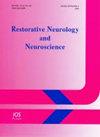Transcranial random noise stimulation to augment hand function in individuals with moderate-to-severe stroke: A pilot randomized clinical trial
IF 1.6
4区 医学
Q4 NEUROSCIENCES
引用次数: 0
Abstract
Background:Interventions to recover upper extremity (UE) function after moderate-to-severe stroke are limited. Transcranial random noise stimulation (tRNS) is an emerging non-invasive technique to improve neuronal plasticity and may potentially augment functional outcomes when combined with existing interventions, such as functional electrical stimulation (FES). Objective:The objective of this study was to investigate the feasibility and preliminary efficacy of combined tRNS and FES-facilitated task practice to improve UE impairment and function after moderate-to-severe stroke. Methods:Fourteen individuals with UE weakness were randomized into one of two groups: 1) tRNS with FES-facilitated task practice, or 2) sham-tRNS with FES-facilitated task practice. Both groups involved 18 intervention sessions (3 per week for 6 weeks). tRNS was delivered at 2 mA current between 100–500 Hz for the first 30 minutes of FES-facilitated task practice. We evaluated the number of sessions completed, adverse effects, participant satisfaction, and intervention fidelity between the two therapists. UE impairment (Fugl-Meyer Upper Extremity, FMUE), function (Wolf Motor Function Test, WMFT), participation (Stroke Impact Scale hand score, SIS-H), and grip strength were assessed at baseline, within 1 week and 3 months after completing the intervention. Results:All participants completed the 18 intervention sessions. Participants reported minimal adverse effects (mild tingling in head). The two trained therapists demonstrated 93% adherence and 96% competency with the intervention protocol. FMUE and SIS-H improved significantly more in the tRNS group than in the sham-tRNS group at both timepoints (p≤0.05), and the differences observed exceeded the clinically meaningful differences for these scores. The WMFT and paretic hand grip strength improved in both groups after the intervention (p≤0.05), with no significant between group differences. Conclusion:Our findings show for the first time that combining tRNS and FES-facilitated task practice is a feasible and promising approach to improve UE impairment and function after moderate-to-severe stroke.经颅随机噪声刺激增强中重度中风患者的手部功能:随机临床试验
背景:中重度中风后,恢复上肢(UE)功能的干预措施非常有限。经颅随机噪声刺激(tRNS)是一种新兴的非侵入性技术,可改善神经元的可塑性,如果与功能性电刺激(FES)等现有干预措施相结合,可能会增强功能性结果。目的:本研究旨在调查 tRNS 与 FES 联合辅助任务练习的可行性和初步疗效,以改善中重度中风后的 UE 损伤和功能。方法:14 名上肢无力患者被随机分为两组:1)tRNS 与 FES 辅助任务练习组;或 2)假-tRNS 与 FES 辅助任务练习组。在 FES 辅助任务练习的前 30 分钟,tRNS 以 2 mA 电流在 100-500 Hz 之间输出。我们对两位治疗师完成的疗程次数、不良反应、参与者满意度和干预的忠实性进行了评估。在基线期、完成干预后的 1 周内和 3 个月内,我们分别对上肢功能障碍(Fugl-Meyer Upper Extremity,FMUE)、功能(Wolf Motor Function Test,WMFT)、参与度(Stroke Impact Scale hand score,SIS-H)和握力进行了评估。结果:所有参与者都完成了 18 节干预课程。参与者报告的不良反应极少(头部轻微刺痛)。两名训练有素的治疗师对干预方案的坚持率为 93%,胜任率为 96%。在两个时间点上,tRNS 组的 FMUE 和 SIS-H 改善程度明显高于假-tRNS 组(P≤0.05),观察到的差异超过了这些评分的临床意义差异。干预后,两组的 WMFT 和瘫痪手握力均有所改善(P≤0.05),组间差异不显著。结论:我们的研究结果首次表明,结合 tRNS 和 FES 辅助任务练习是一种可行且有前景的方法,可改善中重度卒中后的上肢功能障碍和功能。
本文章由计算机程序翻译,如有差异,请以英文原文为准。
求助全文
约1分钟内获得全文
求助全文
来源期刊
CiteScore
5.40
自引率
3.60%
发文量
22
审稿时长
>12 weeks
期刊介绍:
This interdisciplinary journal publishes papers relating to the plasticity and response of the nervous system to accidental or experimental injuries and their interventions, transplantation, neurodegenerative disorders and experimental strategies to improve regeneration or functional recovery and rehabilitation. Experimental and clinical research papers adopting fresh conceptual approaches are encouraged. The overriding criteria for publication are novelty, significant experimental or clinical relevance and interest to a multidisciplinary audience. Experiments on un-anesthetized animals should conform with the standards for the use of laboratory animals as established by the Institute of Laboratory Animal Resources, US National Academy of Sciences. Experiments in which paralytic agents are used must be justified. Patient identity should be concealed. All manuscripts are sent out for blind peer review to editorial board members or outside reviewers. Restorative Neurology and Neuroscience is a member of Neuroscience Peer Review Consortium.

 求助内容:
求助内容: 应助结果提醒方式:
应助结果提醒方式:


